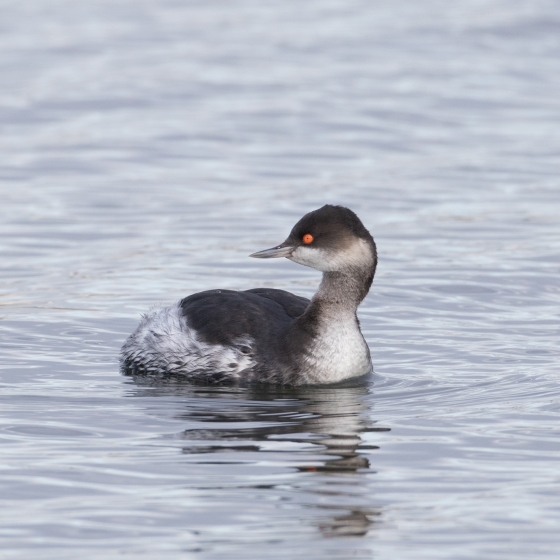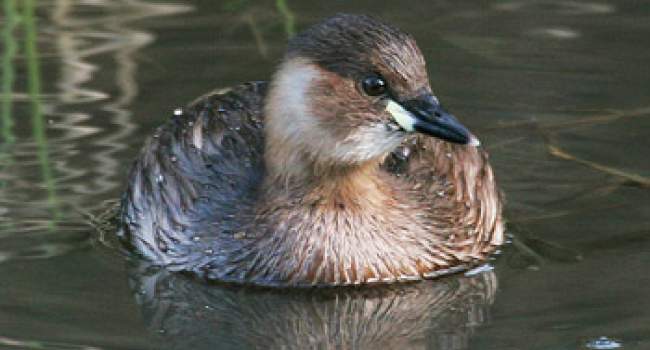Black-necked Grebe
Podiceps nigricollis (CL Brehm, 1831)
BN
 BLNGR
BLNGR  120
120

Family: Podicipediformes > Podicipedidae

Black-necked Grebe is a rare breeding species in Britain, its small population largely restricted to central and eastern England. During the winter months the species may be found more widely on both inland and coastal sites.
Breeding Black-necked Grebes appear to favour shallow eutrophic lakes and pools with an abundance of submerged and floating vegetation. Favoured sites are typically quiet and undisturbed, and the species can be secretive when breeding.
The numbers of wintering Black-necked Grebes suggests that our breeding population is joined by individuals from elsewhere during the winter months.
Identification
Black-necked Grebe identification is sometimes difficult. The following article may help when identifying Black-necked Grebe.
Identifying winter Grebes

From Great Crested and Red-necked to Slavonian and Black-necked, separating grebes in winter plumage can be challenging. This identification video from the BTO discusses all the features to help identify them with confidence.
- ‹ previous
- 2 of 2
SONGS AND CALLS
Listen to example recordings of the main vocalisations of Black-necked Grebe, provided by xeno-canto contributors.
Begging call
Call
Develop your bird ID skills with our training courses
Our interactive online courses are a great way to develop your bird identification skills, whether you're new to the hobby or a competent birder looking to hone your abilities.
Browse training coursesStatus and Trends
Population size and trends and patterns of distribution based on BTO surveys and atlases with data collected by BTO volunteers.
CONSERVATION STATUS
This species can be found on the following statutory and conservation listings and schedules.
POPULATION CHANGE
The first UK breeding record of Black-necked Grebe was in 1904, and breeding numbers remaining very low for most of the twentieth century (Martin & Smith 2007). The population trend has been stable over the 25 years to 2019 (Eaton et al. 2021), having risen between the 1970s and the early 1990s (Martin & Smith 2007). The species has a scattered and localised breeding population in the UK and is monitored by the RBBP with a five-year mean of 53 breeding pairs over the period 2015–2019, almost all in England (Eaton et al. 2021).
DISTRIBUTION
Black-necked Grebes prefers sheltered coastal waters and large open reservoirs in winter. In winter they most abundant around the Thames Estuary and along the south coast of England. They are very scarce breeders in the UK, with most pairs in central and eastern England.
Occupied 10-km squares in UK
| No. occupied in breeding season | 53 |
| % occupied in breeding season | 1.8 |
| No. occupied in winter | 205 |
| % occupied in winter | 6.8 |
European Distribution Map
DISTRIBUTION CHANGE
Black-necked Grebes have become more widespread in winter and the breeding season, although there have been losses in Scotland.
Change in occupied 10-km squares in the UK
| % change in range in breeding season (1968–72 to 2008–11) | +381.8% |
| % change in range in winter (1981–84 to 2007–11) | +67.3% |
SEASONALITY
Black-necked Grebes are present year-round though always scarce, and slightly more likely to be seen in winter.

Movement
Information about movement and migration based on online bird portals (e.g. BirdTrack), Ringing schemes and tracking studies.
RINGING RECOVERIES
View a summary of recoveries in the Online Ringing Report.
Foreign locations of birds ringed or recovered in Britain & Ireland

Biology
Lifecycle and body size information about Black-necked Grebe, including statistics on nesting, eggs and lifespan based on BTO ringing and nest recording data.
SURVIVAL & LONGEVITY
View number ringed each year in the Online Ringing Report
Maximum Age from Ringing 
|
13 years 10 months 5 days (set in 2018) 
|
CODES & CLASSIFICATION
Ring size 
|
F* |
Field Codes 
|
2-letter: BN | 5-letter code: BLNGR | Euring: 120 |
For information in another language (where available) click on a linked name
Research
Interpretation and scientific publications about Black-necked Grebe from BTO scientists.
CAUSES AND SOLUTIONS
Causes of change
The increases in the UK in the 1970s and 1980s are believed to be related to a general increase across north-west Europe (Martin & Smith 2007). However, the reasons for the increases are unclear.
Would you like to search for another species?











Share this page